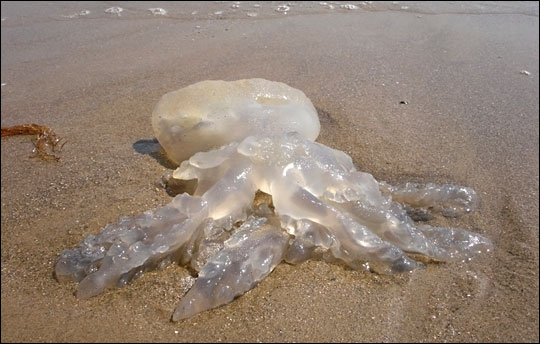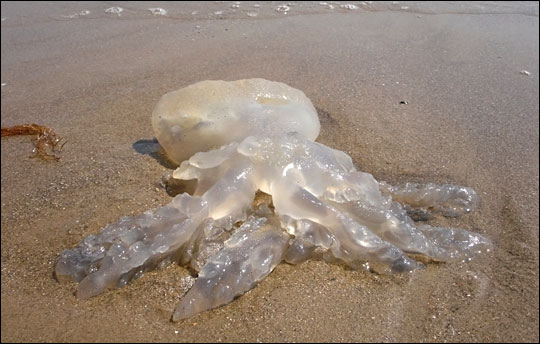In Checkout Line, Lou Bendrick cooks up answers to reader questions about how to green their food choices and other diet-related quandaries. Lettuce know what food worries keep you up at night.

Dear Checkout Line,
I’ve heard that jellyfish are plentiful and that we should eat them. I want to avoid mercury and eat sustainable seafood, but I have to admit that this sounds gross and I worry they are poisonous. I was a fan of How to Eat Fried Worms when I was a kid, but this seems like too much. Are there any other uses for jellyfish other than food? (Can’t we make use of them some other way, like making them into biodegradable grocery bags?)
Curious in Colorado
Dear Curious,
Did you know that How to Eat Fried Worms is an oft-banned book? As it turns out, some parents ask libraries to remove it because they think it encourages inappropriate behavior. Personally, I think that feeding children certain dubious kinds of fish — lice-infested farmed salmon come to mind — is way more inappropriate, and much grosser, than letting them eat worms on a bet.
Jellyfish are indeed poisonous; they kill their prey by stinging them. In fact, the sting of the box jellyfish, found in the waters off of Australia, can cause death or way worse. Most of us who grew up on the East Coast have encountered Lion’s Manes, the purple bane of swimmers that leave a nasty, burning welt worsened by the fact that a bystander will inevitably offer to pee on the victim. (This form of pain relief is a myth.)
The point that I was getting to, before I veered into the topic of urine in a food column, is that while jellyfish do sting, you don’t have to worry about that when you eat them. Jennifer Purcell, a marine biologist with Western Washington University, told me that table-destined jellyfish is processed by soaking it in salt and alum so that the stinging cells are inactivated.
So, yes, we can eat them — but should we?
First, let’s think about aesthetics. Curious in Colorado, I’m guessing your aversion to jellyfish is a texture thing. I totally relate: When a friend told me that she pours milk on her Jell-O, I got woozy. (I guess I’m not cut out for Tony Bourdain-style eating adventures.) Luckily (or perhaps not), the texture of jellyfish isn’t described as wiggly, but “rubber band-like.” Some people really dig this.
“Jellyfish is all about texture, which is why it’s served as a cold appetizer in many Asian cuisines,” ethical seafood expert Taras Grescoe told me.
If your aversion is cultural, here’s a bolstering thought: Bourdain, who has eaten weird things all over the world, including warthog rectum (really!), has said that the most disgusting thing he has ever put in his mouth was a Chicken McNugget. Speaking of rectums (how often do you get to say that?), the mouth of the jellyfish is also its rectum.
Sorry — where was I? Oh, that’s right. How jellyfish taste: bland.
“It’s a great conveyor of flavor, particularly of sesame seed oil, soy sauce, and hot chile peppers,” insists Grescoe. Purcell concurs: “It tastes like the sauce.”
If you want to try jellyfish, look for it on the menu at Chinese restaurants, or in Asian grocery stores (jellyfish has been eaten in China for a millennium), where it will be dried and packaged. Having said that, I tried to get some in my town and struck out.
So what have we learned so far? Let’s pause for a moment and say, for argument’s sake, that you can:
A) get over the grossness thing, be it cultural, textural or otherwise.
B) get your hands on some jellyfish.
C) get the peeing-on-writhing victim and mouth-rectum images out of your head.
So — should you eat it just because it’s sustainable?
On one hand, yes.
Unlike many sea critters, jellyfish tend to be too abundant, not overly scarce. According to Purcell, who specializes in jellyfish, scientists are reluctant to say that jellyfish populations are increasing because the long-term data is lacking (because jellyfish are so little-studied). But “problem blooms” seem to be increasing.
These blooms shut down power plants, menace swimmers, and wreak havoc with fishermen. As it turns out, we caused these blooms by screwing up the oceans and creating a paradise for jellyfish — we removed their predators by over-fishing! (Do you feel like you’ve seen this movie before?)
In addition, we also gave certain jellies ideal habitats by building coastal structures (marinas, powerplants, etc.) to attach themselves to so that they can breed like little water rabbits. But that’s not all: Jellyfish not only enjoy globally warmed waters (Purcell showed that some temperate jellyfish breed faster in warmer water), but also thrive in eutrophic water caused by fertilizer runoff, which gives them yummy things to eat and simultaneously kills their competition.
Meanwhile, jellies and their wiggly kinfolk, such as the invasive comb jellyfish, are getting portered all over the world in the ballast waters of ships. As if this all weren’t enough, hundreds of millions of jellyfish are released into the ocean in China, where they are cultivated for aquaculture. Read all about the causes and consequences of blooms here [PDF].
So, naturally it would seem like eating jellyfish is the least we can do.
“As bigger species, like cod, swordfish, and tuna, are fished out, jellyfish are proliferating in oceans around the world,” says Grescoe. “I figure we should get on board and start eating them, as they do in China, Vietnam, and Hawaii.”
“You may help the problem by removing the jellyfish,” says Purcell, “in conjunction with reduced fishing.”
On the other hand, hold the soy sauce.
I personally worry that resigning ourselves to eating jellyfish is a form of brainless adjustment to an environmental crisis. Perhaps instead, we should heed that grossed-out feeling we’ve had throughout this entire article and start getting serious abut the dire state of the oceans.
In this essay [PDF] in Edible East End magazine, Dr. Carl Safina and ecologist Marah Hardt ponder these questions: “Will jellies rally us to heal a sickened sea? To cleanse pollution? To turn our fisheries around? Or will we get used to jellies like we are getting used to the decline of most fish?”
As for alternate uses for jellyfish, I like your idea for a jellyfish grocery bag. Maybe if it glows and has stinging tentacles, I will actually remember to bring it to the store. Who knows, it may happen: one Japanese entrepreneur is trying to popularize jellyfish in his homeland (where 400-pound, Son-of-Blob jellyfish clog fishing nets), creating everything from cocktails (I’ll have a jellyfish sour, barkeep) to makeup (its mucus is great for dry skin).
Jellyfish, in a pulverized form, have also been made into cookies. On a more serious note, a lab rat study showed that collagen from cannonball jellyfish suppresses the onset of arthritis. Most famously, three scientists won the Nobel Prize in chemistry for making living things glow in the dark with the help of a jellyfish gene. (Heck, I used to be able to do that with fluorescent paint and a black light.)
Whatever you decide to eat, just don’t let anybody pee on you.
Stay curious,
Lou


